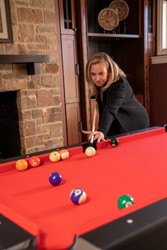What To Consider When Purchasing a Non-Slate Pool Table
Posted by Mark Clements on 23rd Nov 2021

A pool table will add countless hours of fun and excitement to your home recreation space. Since the Covid-19 pandemic, pool has regained popularity and is now one of the most popular games being played in the United States for home recreation. Pool transcends cultural barriers, age differences and is enjoyable for anyone who decides to play. Choosing which table is right for you ultimately comes down to who will be using the table, what you intend to use the table for, how long you expect it to last, the room space you have available for the table and your budget. Below we'll provide you with everything you need to know to select the perfect non-slate pool table for your home.
How do you select the perfect non-slate pool table?
Playing Surface Material: Pool is a game that's all about angles and positioning, so keeping the play surface 100% level is essential to ensure accurate game play. The preferred play surface for a non-slate table is medium density fiberboard (MDF). MDF is an engineered wood made from wood fibers that have been combined with wax and a resin binder and then formed into panels by applying high temperature and pressure. MDF material is similar to billiard slate because it is consistent throughout and has a perfectly smooth surface. It's main advantage over slate is that it is lighter weight and less expensive to produce. Quality table manufacturers will use a 3/4" thick MDF panel that has been seal coated for extra protection against warping.
Leg Support System: Since the legs support the entire weight of the pool table, they must be strong and rigid to provide optimum support and stability to keep your table level. It is common for players to lean on or brush up against the table during game play while lining up for difficult shots, which adds even more stress to the support system and reinforces the need for a rock-solid foundation. There are many different leg styles to choose from and they vary greatly in appearance including carved legs, square post legs and pedestal legs. The most important thing to remember is the legs should firmly anchor to the table cabinet/frame and provide optimum stability. Quality tables will include built in levelers that allow you to easily adjust the height of each corner and achieve a level surface even when the floor is sloped.
Portable Folding Pool Tables:
Smaller portable non-slate pool tables with folding legs have recently become very popular and are a great option for someone who wants a table but does not have the dedicated space available. If the smaller portable table is something you are considering, we recommend that you review the type of leg support and accessories included with the table. Many of these tables have a cheap metal folding leg support system and downgraded accessory items, especially the cue length and ball diameter. There are a few quality portable pool tables available in the market place that look and play like the much larger stationary full-size tables. Our Ashford 6' folding pool table is a great example of this!
Support Frame: The play surface of a non-slate table is only as good as the support system it rests on. Without a sturdy frame, the surface can sag and become uneven over time. A quality pool table will include a minimum of two cross and two center support beams with full perimeter support. Proper surface support will help to ensure the surface stays level and maintains accurate table play.
Cloth/Felt: The type and quality of the felt on your table will impact the speed and spin of the ball, as well as how long the felt will last, so there's a lot to consider. The recommended cloth for recreational play is an 18 to 22 ounce cloth that is made from a blend of 70% wool and 30% nylon that has been treated with a stain and moisture-resistant coating. The above combination will provide exceptional durability, better overall performance and accurate table play.
Top Rails: The rails are located on the top edge of a pool table and are one of the most important components on the table. The width of the top rail can vary depending on the table style, but wider rails allow additional space for hand bridging off the rail when attempting shots in which the cue ball rests close to the rail. The rails can be made from a variety of woods and are intricately machine molded for exact angles and heights. The cushion bumpers are glued directly to the wood top rail and are covered by billiard cloth. One of the most important things to remember is that the top rails must be firmly anchored to the play surface. If they are not, the rails will have "dead spots" and the ball rebound will be inconsistent, which will negatively affect table play.
Cushions: Although there are many different cushion profiles available, we recommend a K-66 profile natural gum rubber cushion that features a canvas-backing and control canvas on the top. The canvas on the back of the rubber helps adhere the cushion to the rail and the canvas on the top of the cushion controls the action of the rubber ensuring more accurate and consistent play. This cushion profile has been around for many years and has proven to deliver lively rebound action and top-quality table play.
Playing Equipment: Many non-slate tables come with included accessories. The quality of these accessories is usually entry level and, in some cases, not standard size equipment. It is important to carefully review the equipment included with the table, especially the diameter of the balls and the length and material of the cue sticks. Standard size balls are 2.25" in diameter and the industry standard for a cue stick is 58". Most cues that are used for home recreation are a 2-piece hardwood design, have a weight range between 17 and 21 ounces (19 ounce being the most common) and feature a tip diameter of 12-14mm. By playing with inferior equipment, your performance will be negatively impacted and it will slow down your improvement progress.
Room Size/Space Needed: What size table you should buy is largely dependent on the amount of space you have to put it in. Just because you have a large room that can accommodate a larger table size, you must consider the extra amount of space that is needed to draw your pool stick back when taking a shot. If the space is too small, your cue will constantly bang into a wall or surrounding furniture, making game play very frustrating. A simple way to determine the adequate space needed for a table is to add the length of two standard 58" cues (116") to the length of the table and repeat this same process on the width of the table. These two measurements are the room dimensions needed for comfortable table play.
If you're in the market for a non-slate pool table, be sure to check out our full assortment where we've already taken into consideration all of the above information during the design phase of our products to deliver a quality table that looks and plays great. We hope the above information was informative and will help you make the right decision when selecting a table for your home recreation space!

Mark Clements
V.P. of Merchandising | Freetime Fun

